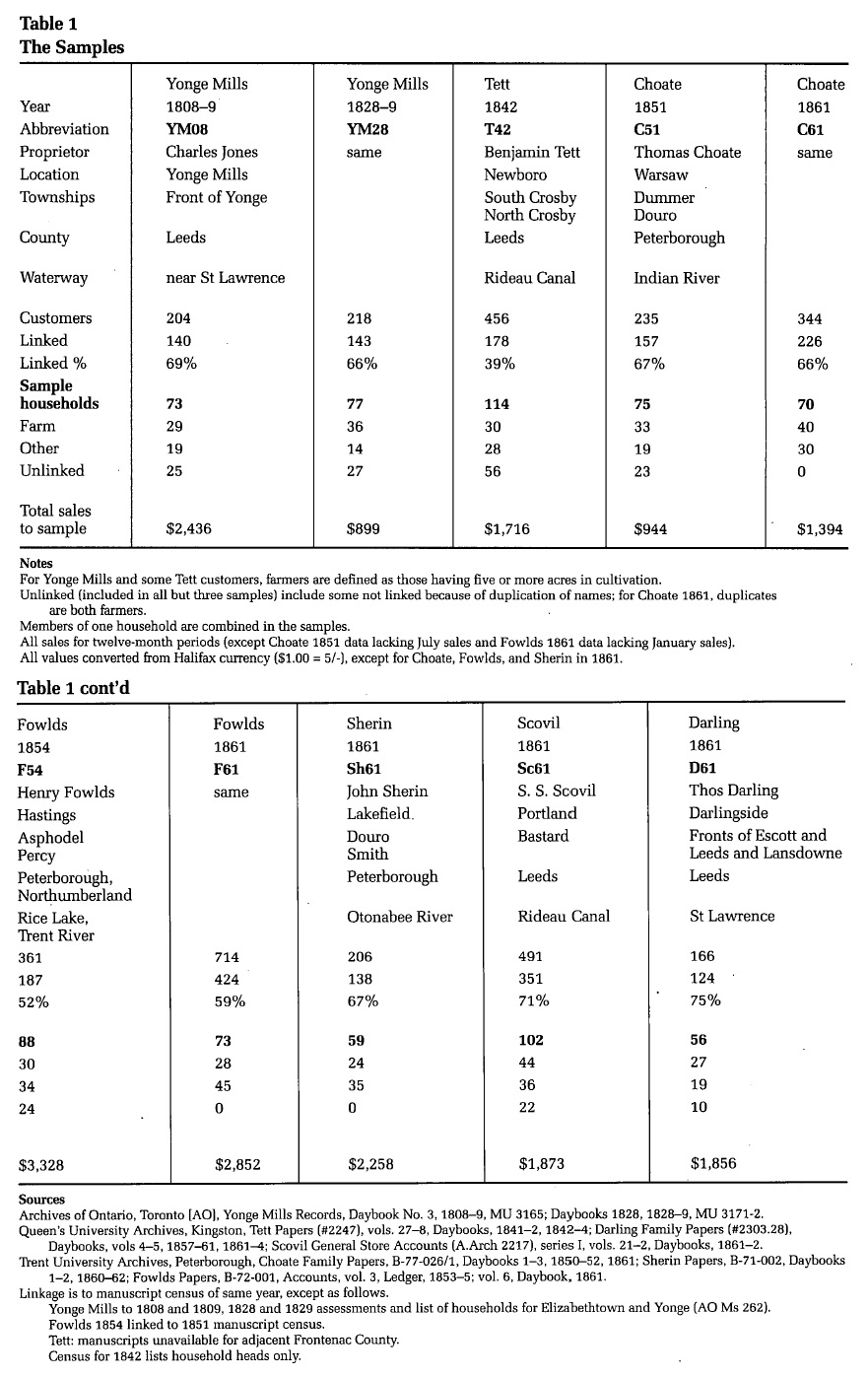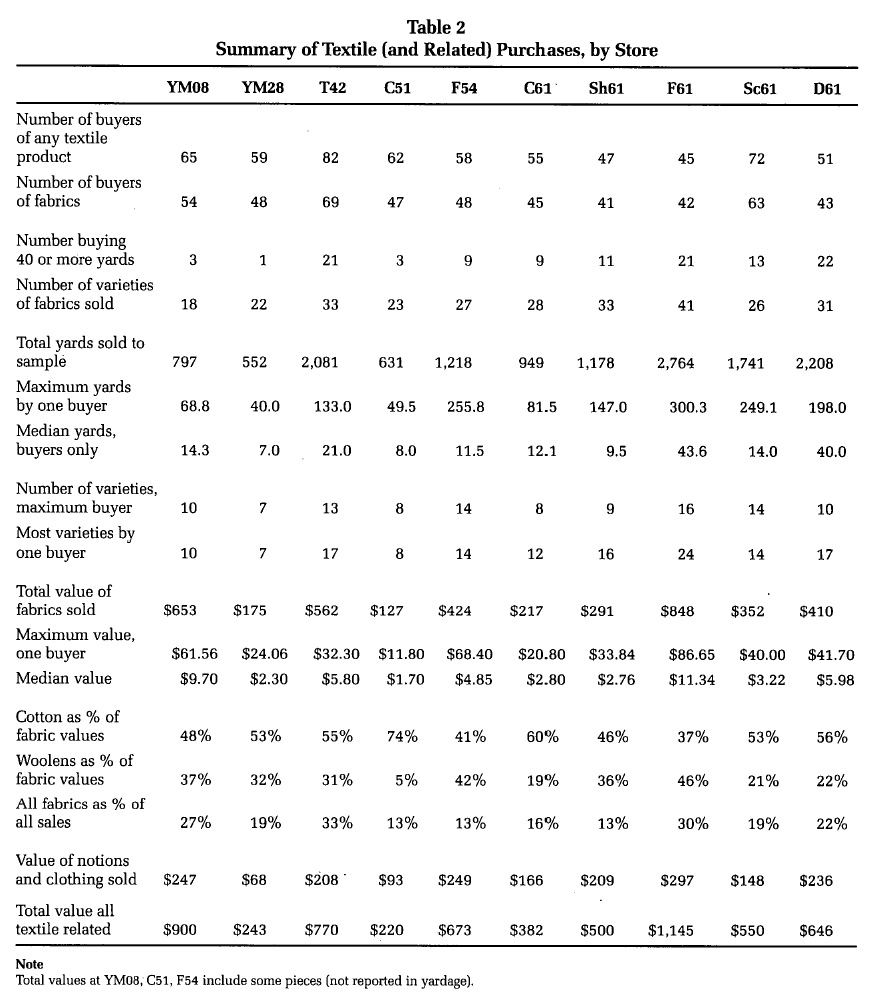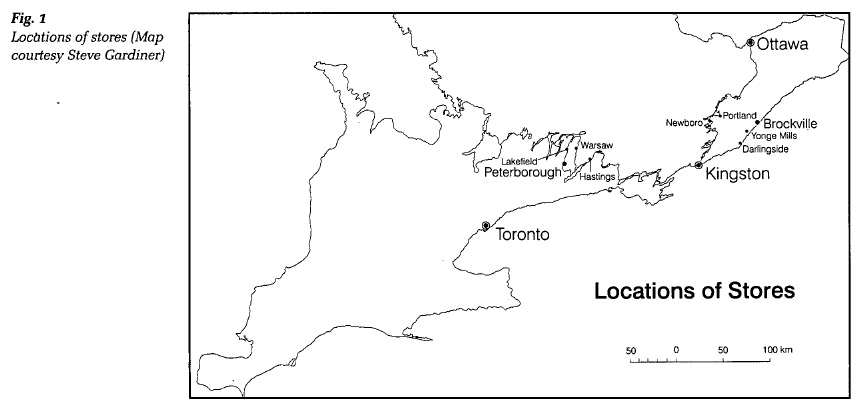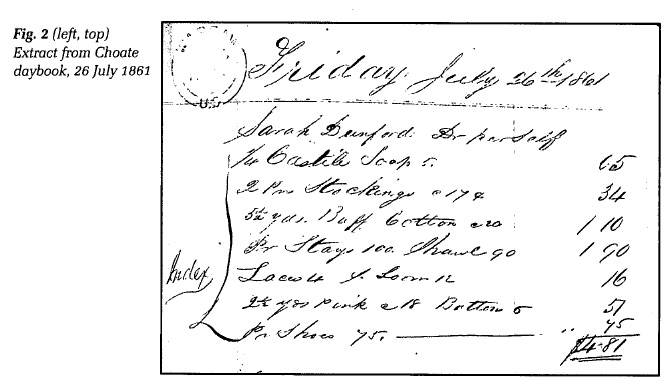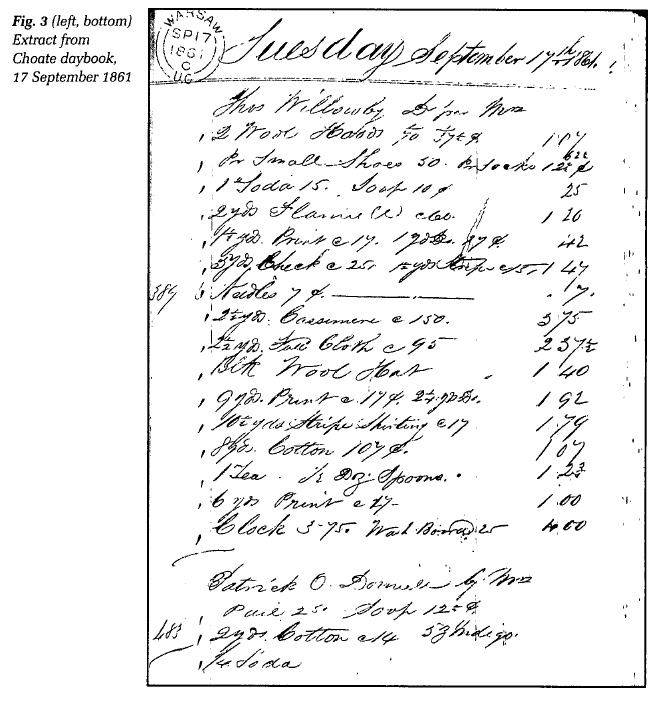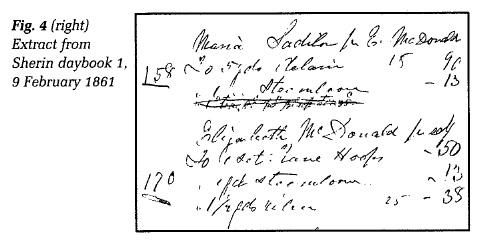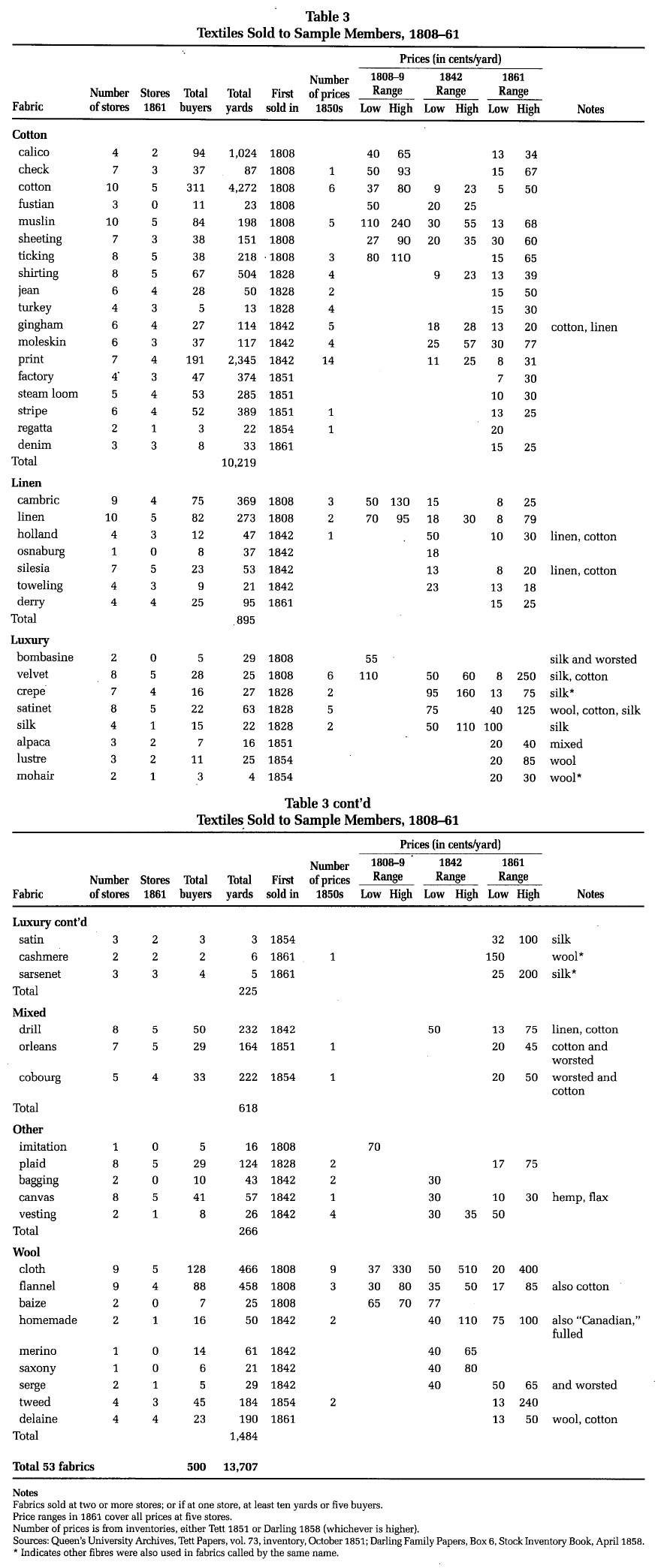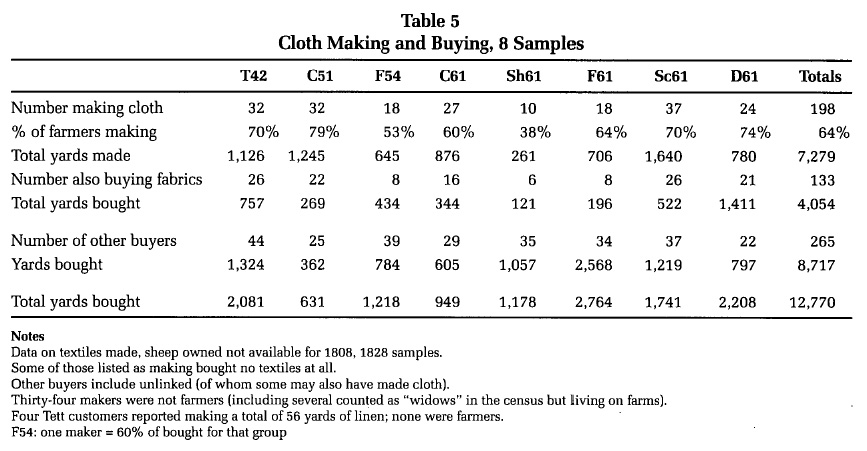Articles
Textile Purchases by Sorte Ordinary Upper Canadians, 1808-1861
Abstract
What we know of the manufactured textiles that were usually the largest single category in colonial imports relates mainly to elite families and special occasions. This paper uses ten samples of the accounts of ordinary families, principally farmers and artisans, at seven Upper Canadian village stores (the earliest in 1808-9, the latest in 1861). Almost 600 of the 787 sample members made at least one purchase of textiles or a related product. From their accounts, 53 fabrics, 36 readymade products, and 38 other products are selected. Cottons dominated from the beginning, and purchases of luxuries, such as silk, were rare. The basic patterns confirm for Upper Canada what textile historians have found, using estate inventories, in other colonial contexts. However, they challenge the story, which underlies most specialist and general accounts of Upper Canada, that there was a transition in this period from self-sufficiency to market engagement.
Résumé
Ce que nous connaissons des textiles manufacturés, habituellement la plus grande catégorie d'importations coloniales, se rapporte surtout aux familles de l'élite et aux occasions spéciales. Cet article examine dix échantillons d'états de compte de familles ordinaires, principalement de fermiers et d'artisans, dans sept magasins de villages du Haut-Canada (le plus ancien remontant à 1808-1809, le plus récent à 1861). Près de 600 des 787 membres de l'échantillonnage ont acheté au moins un article textile ou produit connexe. Dans les états de compte, 53 étoffes, 36 vêtements de confection et 38 autres produits ont été sélectionnés. Dès le début, les cotonnades étaient ce qui se vendait le plus et les achats de produits de luxe, comme la soie, étaient rares. Les tendances fondamentales confirment pour le Haut-Canada ce que les historiens du textile ont découvert dans d'autres contextes coloniaux en consultant des inventaires de successions. Elles mettent cependant en doute la croyance répandue dans les récits généraux et les écrits de spécialistes sur le Haut-Canada, selon laquelle cette époque en était une de transition de l'autosuffisance à l'économie de marché.
Fashion in the Countryside?
1 In the growing body of work on the history of consumption in Canada, the colonial era remains relatively under-explored.1 In economic history, the orientation to staple production has made the pertinent consumption issues diets in southern Europe and Brazil, hat fashions in Europe, and the preferences of native consumers, not the food, clothing, and shelter (and standard of living) of British and French settlers and their descendants.2 Other approaches do have more to say, if often implicitly. For example, we have learned much more about women's market-related work; someone was hiring them or buying what they sold, and they in turn were spending the income they gained.3 Still, the most powerful image for the colonial period remains one of family self-sufficiency, and the long-term story a transition from self-sufficiency to market involvement. For textiles, as Hood and Ruddel have noted, there has been a "strong bias towards a 'homespun' or romanticized interpretation."4 Women made their families' clothes from fabrics they had themselves made, from wool and flax the family had itself produced. As the standard history of women in Quebec puts it: "La plupart des femmes s'habillent en étoffe du pays qu'elles filent, tissent, teignent et coupent."5
2 For Upper Canada, K. B. Brett, one of the leading students of costume history, tells a similar story: "of necessity, clothing was produced from homespun as part of the largely self-sufficient domestic farm economy." She emphasizes actual physical scarcity, as "shipments were infrequent and popular items quickly ran short." Yet despite their remoteness from Britain, "Canadian women quickly followed every change, and wrote home for the latest fashion news." Somewhat contradictorily, but consistent with her discussion of homespun, Brett also says that women "in the rural areas, cut off from the outside world, had little time to bother with changes in style." By the mid-nineteenth century, that isolation had ended. Now improved communications made supplies "more readily available... [T]here were more ready-made goods in the shops [and] [t]he practice of making everything possible in the home, as well as making over and making do, were no longer a necessity..."6 Did better communication bring increased consciousness of fashion? Concluding her authoritative work on Canadian fashion in the nineteenth century, "Clothing Worn in Canada" (in the Canada's Visual History series, reissued on CD-ROM in 1994), Brett is skeptical. "It is unlikely that the majority of women in Canada, living active lives in towns, villages, and small communities, succumbed to the dictates of fashion, except for church on Sundays and special occasions. One could wish that more everyday clothing survived to prove this point."
3 Brett's work, like much of the best and most specific research on consumption in Upper Canada, is dominated by the need to represent the past visually, notably in museum and living history settings. Unfortunately, as such researchers know very well, surviving artifacts can be unrepresentative of what once was in everyday use.7 Written sources and visual images come mainly from elite levels of society and often from metropolitan centres (Brett uses Godey's Lady's Book and Tailor and Cutter, for example). Using them to understand ordinary people and everyday life requires assuming that those about whom little is known followed trends in elite circles, albeit with a lag. An alternative to the fashion-based approach is to generalize over time on the basis of what is known only for a specific era. Thus, Brett's account of country clothing in nineteenth century Ontario uses paintings and photographs from the 1870s and 1880s and many artifacts from the period of improved communications and greater market access after 1850 (these include all the homespun dresses). For them to represent the whole settlement era, it is necessary to assume that costume was relatively timeless, changing little over a century.
4 To be more specific, let us consider the problem of the silk dress. The principal fabric on the Canada's Visual History CD-ROM, illustrated by more than half of the dresses and children's outfits pictured, is silk (yellow silk, figured silk, ribbon silk, tartan taffeta, etc.). Also extensively illustrated and discussed are such luxury fabrics as velvet, satins, and fine white muslin. Brett reconciles these with her account of pioneering in Upper Canada by making a silk dress, cleverly reworked from time to time, the representation of fashion in an otherwise largely homespun world. She depicts "busy and practical women [who] spent most of their time in simple and serviceable dresses, of gingham or printed cotton when available, but more often of homespun and handwoven wools and linens...which they made themselves. What thought they had for fashion was displayed in the best silk dress, the pride of every woman who owned one."8
5 This is an appealing image. And by mid-century, when useful trade figures become available, imports to the Province of Canada of silks, satins, and velvet were substantial, totaling $780 000 in 1851 and $920 000 in 1861.9 Those figures were, however, very much lower than for imports of cottons and woolens, which were worth $3.9 million and $2.9 million respectively in 1851 and $5.7 million and $4.3 million in 1861. Although Brett pays considerable attention to linen (and says most under garments were made of linen until after 1850), its imports were modest, $450 000 in 1851 and $340 000 in 1861. Nor was there much domestic production by then in Upper Canada; the 1851 Census reported less than 15,000 yards* of linen production in the whole province, and not even 500 yards in the two counties discussed in this paper.10 That millions of dollars worth of fabrics were imported fits Brett's image of greater abundance in provincial shops. Unfortunately, trade data do not further specify fabrics, equivalent data are not available earlier, and imports cannot say who purchased which fabrics.
6 Faced with this problem and the limitations of literary and visual sources, many students of consumption in the colonial era have turned to estate inventories, which record what people possessed when they died.11 For all their value, inventories can be inconsistent in coverage, and a number of assumptions are required to relate an inventoried stock to the flow of transactions during a lifetime. Moreover, the best that can be said for these documents in Upper Canada is mat their quality has yet to be tested. Hence this paper explores what another type of routinely generated source, country store accounts, can contribute to the discussion of consumption. Its premise is that even if clothing and other textiles do not survive, we can at least know more about the fabrics that went into them. From this evidence, there is reason to doubt that the luxury fabrics emphasized in Brett's account actually were common in the countryside. That is, it confirms her skepticism about extrapolating from the fashion concerns of a handful of elite members to the larger society. On the other hand, purchases of imported fabrics also qualify the images of homespun that often dominate the story.
The Country Store Study So Far12
7 The evidence in this paper comes from ten samples from seven different stores, five in 1861 and five from earlier (1808, 1828, 1842, 1851, 1854; see details of samples and of their textile purchases in Tables 1 and 2). The samples were prepared in an effort to make systematic use of country store accounts as a pathway into the rural economy of Upper Canada. The procedure was to seek the names of all customers who appeared in the retail accounts during a year in the nominal and agricultural census manuscripts for nearby townships. From those who could be identified, samples were structured to represent both farm households and others in the local economy, and their transactions during the year were recorded. Except for the Fowlds and Sherin stores in 1861, farmers were a substantial majority of the clientele who could be linked to the census and are a majority in seven of the linked samples. There was, however, a smaller chance that any particular farm household would be in a sample than a non-farm household. Most of the samples also include some unlinked customers, for whom we have only the information available in their accounts; a number of them were women.
8 The stores were located in two counties in the eastern half of the province, where the rural economy was based on forest products as well as farming. The earliest samples are from Yonge Mills, located in Leeds County near the St Lawrence River west of Brockville, and Newboro, a village at the rear of Leeds, on the Rideau Canal (see Fig. 1 for location of stores). Two of the 1861 samples are also from Leeds, one from the front and the other from the rear of the county. The samples from the 1850s and three from 1861 are from Peterborough County, where settlement began almost forty years after the first Loyalists arrived in Leeds. The decision was made to base the study in 1861 and work backwards because there was a good census and an abundance of high quality accounts for that year. If late in the settlement era, it predated the development of ready-made clothing and consumer brands and most of the diffusion of the sewing machine. Farming was by far the dominant occupation in the province, and although the proportion of the population living in an urban centre was rising, only one in six Upper Canadians lived in a centre of 1000 or more (as compared to one-half of Ontarians fifty years later). Of the five communities sampled in 1861, the population of Hastings was 500; Warsaw, Lakefield, and Portland each had populations of less than 200; and Darlingside, a landing on the St Lawrence River, was not a village at all. None were on a railway even after a decade of railway building in the province, and all were at least eight miles from a major town. All ten stores were part of a more diverse set of local enterprises, including flour and saw mills, timber shanties, carding and fulling, and potash production. For example, Yonge Mills had a carding mill in 1808 and in the 1820s was one of the province's largest grist mills (and only incidentally a local mill at the same time), Choate in 1851 and Fowlds in 1861 had carding and fulling mills, and Darling sold firewood to passing steamboats.
9 All the stores sold dry goods, footwear, groceries, hardware, housewares, some finished clothing, notions, and some local produce; a number also supplied local artisans with inputs to their own production. There were variations among the stores in scale and emphasis, and in how associated operations appear in their accounts. Thus, fabrics accounted for between one-eighth and one-third of total sales (all totals refer to sample customers only), and total sales ranged from $900 (at two stores) to more than $3,000 (in one Fowlds' sample). At the latter store, produce purchased by non-farmers (flour from the mill, pork, and beef in particular) often appeared on accounts, but this store also had the largest textile sales, 2,764 yards in 1861, worth over $800. Earlier work on these samples has found very wide variation in the quantities purchased by individual households, even of everyday essentials. Thus, about one-third of the sample bought no fabrics at all, and some others bought very little. It is not possible to infer lack of consumption from an absence of purchases, however, because few bought all their needs at a single store. That is, we cannot know what proportion of any household's consumption was represented by its purchases at one store.
Fabrics and Related Products
10 Textiles were needed for much more than clothing. Bedding, draperies, towels, table linens, and floor coverings were essential in daily living, as were bags, covers, and other products used in farm and other work. All, of course, were subject to wear, at varying rates. In addition, those who followed fashion or had more disposable income had other, reasons to buy fabrics. Estimating demand for fabrics depends, therefore, on the assumptions made. For clothing, a convenient figure is Adrienne Hood's careful, lower-bounded estimate that 45 yards per year was "the yardage required annually to meet some minimal clothing requirements" for a household of six persons in eighteenth century Pennsylvania.13
11 For this paper, evidence has been extracted on purchases of fabrics and of ready-made and textile-related products such as handkerchiefs, dyes, buttons, and thread. The names of fifty-three fabrics are included in Table 3, which is organized by the type of fibre and by the year each fabric first appears in the samples.14 Information is given on the total number of stores that sold the product (and the number of stores in 1861), the total yards ever sold, and the total number of buyers. With the exception of some homemade cloth (see wool), all of the material was imported from Britain. Assigning fabrics to categories has arbitrary elements: the same name might be used for fabrics made from different fibres; some names may be alternatives for, inclusive of, or subsets of others; standard references sometimes disagree on the implications of a term; usage changed; and account entries are sometimes illegible or ambiguous. Fortunately, main patterns would change little if different assumptions were used. In general, categorization follows the language of the accounts. For example, cotton (the fabric, not the category) includes all transactions in which this term was used, even if an occasional adjective such as stripe or check might have led to including it with fabrics called just "stripe" or "check."15 Because most woolens were recorded as "cloth," a few transactions mentioning broadcloths such as fearnought, kerseymere, coating, and trousering are also included in that group. Fowlds' store in 1861 was the only one selling both calico and print; either they were close substitutes for one another or usage had tended to merge the terms.
12 Several 1861 transactions on sample members' accounts serve to illustrate these issues and the character of the documents. For example (Fig. 2), at Choate's in Warsaw on Friday, 26 July, Sarah Dunford purchased 5-½ yards of buff cotton at 20c: per yard and 2-½ yards of "pink" (cotton assumed, on the basis of price of 18¢). Among her other purchases that day were two pairs of stockings at 17¢ each, a pair of stays ($1.00), a shawl (90¢), and some buttons (6¢). On Tuesday, 17 September (Fig. 3), Mrs Thomas Willoughby bought eight different fabrics totaling almost 52 yards (and valued at $15.00): 2 yards of flannel, 19-¾ yards of print (in 5 pieces ranging from 1 to 9 yards), 5 yards of check, 1-½ yards of stripe, 2-½ yards of "cassimere," 2-½ yards of fulled cloth, IO-½ yards of stripe shirting (which was recorded under shirting), and an 8-yard piece of cotton (for $1.07). She also bought 2 wool hoods (at 70¢ and 37-½¢), a pair of socks (12-½¢), 6 needles (7¢), a black wool hat ($1.40), and a wash board (25¢). Later that day (farther down the page and not shown here), she also purchased 2 crinoline sets at 60¢ and 80¢. Also shown on 17 September are Mrs Patrick O'Donnell's purchases, which included 2 yards of cotton (at 14¢) and 5 ounces of indigo (not priced here, but estimated at 12¢ per ounce on the basis of other entries in Choate's accounts). Two other examples (Fig. 4) are transactions on 9 February at Sherin's store in Lakefield. Elizabeth McDonald purchased 5 yards of delaine (18¢ per yard) and 1 yard of steam loom (13¢) for Maria "Sadiler" and a yard of steam loom, a set of "kane hoops" (50¢), and 1-½ yards of "riben" (25¢ per yard) for herself.
13 These transactions would be of no more than anecdotal interest without the context supplied by other information.16 From the census, we know, for example, that Maria Sadler (aged 16) and Elizabeth McDonald (aged 15) were members of the Church of England, born in Upper Canada. They were "serving maids" in the household of Robert Strickland, a 31-year-old farmer (and nephew of Catharine Parr Traill), with three young children. Sarah Dunford was an English-born Bible Christian, married to labourer Stephen Dunford. Aged 51 and 52 respectively, they lived in Douro, with a six-year-old boy. Thomas Willoughby was a 24-year-old farmer, a Protestant born in Ireland, with 100 acres in the backwoods of Dummer six kilometres northeast of Warsaw. He was, evidently, a pioneer farmer, with just 1-½ acres in cultivation (and another 30 in pasture). He had a horse, 2 oxen, 3 steers, 4 milk cows, and 1 pig, but reported no sheep or wool production. His wife Sarah, who made these purchases, was 28 years old. They had no children, but 15-year-old Ann Pomeroy was also living with them when the census was taken.
14 More important for this study is the context of these families' accounts over the year, and of purchases by others in the samples. Sarah Willoughby's large and diverse set of purchases on 17 September (almost all the textile-related purchases charged to their account over the whole year) proves to have been among the largest one-day orders of the entire sample. Still, as we will discuss further below, the Willoughbys very much reflected Choate's principal textile buyers; in fact, they ranked seventh in yardage and second in value. Similarly, Mrs O'Donnell's purchases during the year of 42-½ yards of fabric ranked her ninth in yardage. Her modest purchase of indigo was also typical.17 It is not clear why Sarah Dunford, a married woman, had an account in her own name; in any case, there is no indication that her husband ever used this store. The delaine purchased for Maria Sadler and the hoops bought by Elizabeth McDonald were both relatively common purchases in 1861 (Elizabeth, in fact, had bought 2-½ yards of delaine for herself four days before). On the other hand, in the entire sample, besides Sarah Willoughby, only one person purchased cashmere, only one bought a crinoline set, and only two bought hoods; besides Sarah Dunford, only three bought stays.
15 Customers in the first sample, at Yonge Mills in 1808-9, bought 18 different fabrics (see Table 2; 15 of these are listed in Table 3).18 These included fabrics in every category in the table except the "mixed" group; among them were cotton, calico, muslin, cambric, linen, cloth, and flannel, all still important in 1861. In total, sample members purchased more than 800 yards of material, including over 500 yards of cotton products, 180 yards of wool and flannel, and less than 80 yards of linens. The cotton was worth about $300, almost half the value of all textile sales, and the woolens over $230.19 As is evident from Table 2, this pattern resembled those of later samples. In terms of values, cotton was the principal fabric at most stores and accounted for over half the value of fabrics sold at six of them. In terms of yardage (Table 3), cotton was by far the leading fabric. Of the 13,700 yards of fabrics purchased by sample customers at the ten stores, over 10,000 were cotton. In all, 500 different households are represented here; only print (sold at 7 stores) and cotton were purchased by as many as half of all buyers; calico (sold only at 4 stores) was bought by almost as high a proportion. Next most important were woolens, at about 1,500 yards. Generally much more valuable on a per-yard basis, woolens ranked second in value to cotton at seven stores, and first at two. Wool cloth also ranked next behind the main cottons in terms of numbers of buyers. Other textile purchases were 895 yards of linen, about the same amount of "mixed" and other fabrics, and 225 yards of what are here called luxury fabrics.
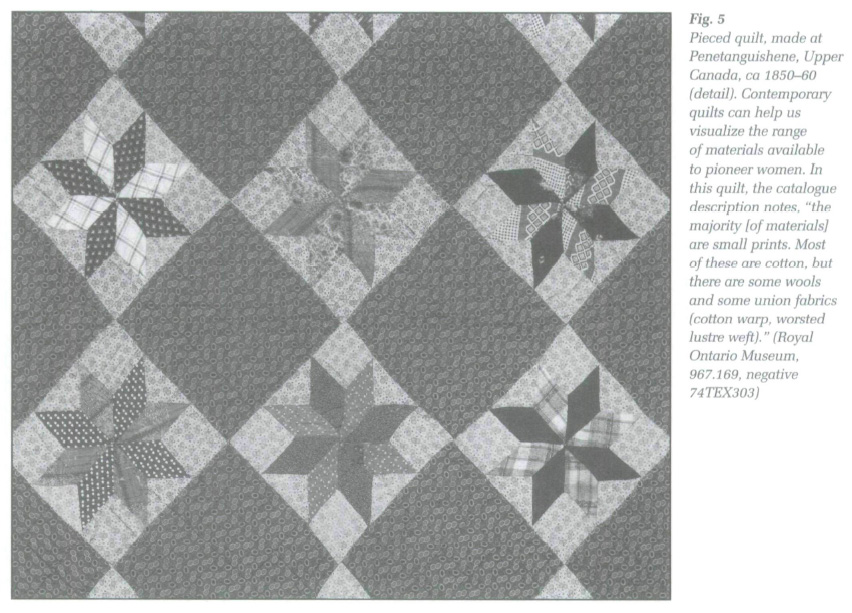 Display large image of Figure 5
Display large image of Figure 516 Each succeeding sample adds new fabrics to the list. Thus, 7 appear among the 22 kinds sold at Yonge Mills in 1828—9, despite lower total yardage and values than in 1808; another 14 among the 33 fabrics sold by Tett's store in 1842; 11 from the two samples in the 1850s, and 5 from the samples in 1861. The greatest variety of fabrics sold at one store was the 41 sold by Fowlds in 1861. Among the additions were several fabrics new in the nineteenth century, such as tweed (1825), delaine (the 1830s), Orleans (1837), alpaca (1841), and cobourg (the 1840s). All but delaine appear in Table 3 in one of the 1850s samples. On the other hand, some fabrics disappear during the period, such as bombasine and fustian (last seen in 1828 and 1842 respectively) and osnaburg, merino, and saxony (all seen only at Tett's in 1842, and not on its inventory in 1851). The wide variations in numbers of buyers and in yardage make clear that some fabrics were very much more important than others. On the other hand, country merchants stocked a substantial variety of fabrics; if people did not buy more of those sold in small amounts, it seems unlikely to have been because they were not available.
17 Among the fabrics listed in Table 3 are many that Brett discusses. For example, 15 households bought a total of 22 yards of silk (from four stores), 3 bought a total of 3 yards of satin (from three stores), and 28 bought 25 yards of velvet (from eight stores). There were no purchases of taffeta, however. Obviously these yardages were not dress-sized pieces: the largest individual piece of silk was 2.5 yards. Of the luxury fabrics, only satinet (not mentioned by Brett) was sold in at all substantial amounts (63 yards sold to 22 buyers at eight stores). Several others were more common. For example, 27 households bought a total of 114 yards of gingham (including five pieces of five yards or more) from six stores; and 84 bought muslin, a total of 198 yards, from ten stores. Most of the muslin was, in fact, purchased in 1861, after it had fallen sharply in price. The 43 buyers between 1808 and 1854 purchased only 50 yards, and only one piece over 5 yards in length. As for cotton print, said by Brett to be used "when available," 191 customers bought a total of 2,345 yards. (See Fig. 5, detail of a quilt, in which more than a dozen different pieces are visible, many of them printed cottons.)
18 As students of textile history know, there were variations in quality and character, often very wide ones, within many specific fabrics. These are suggested in Table 3 by the price ranges in 1808-9, 1842, and 1861 and by the number of distinct prices in one or other of two store inventories from the 1850s. For example, Tett's 1851 inventory has 14 different print prices and 9 different prices for cloth. The actual prices in the table are the lowest and highest price per yard in each year. In some cases, a remnant or a very small piece may have produced an unusually low or high price per yard. In others, the price range may actually cover distinct products. In particular, the emphasis on luxury fabrics in some of the literature made it important not to omit any transactions in crepe, velvet and silk; the lower priced transactions were more likely for trim, not pieces of cloth, or even for imitations. Between 1808-9 and 1842, prices fell sharply for cotton and linen. The high end of the range for both muslin and linen in 1842 was just half the low end of the range for these products in 1808. Most of the decline, in fact, had already occurred by 1828. The change was real: at the prices paid for wheat by Yonge Mills, a bushel of wheat would have bought about twice as much calico or cotton in 1828-9 as in 1808-9.20 By contrast, prices of many woolens did not fall. The best woolen cloth in all three years cost well over $3 per yard, more even than silks (although broadcloths, at 54 inches, were at least half again as wide as other fabrics).
19 In addition to textiles, these stores sold many ready-made textile and related products (Table 4). With one exception (corsets), only products sold at two or more stores are included. The most commonly purchased were handkerchiefs, hats and caps, gloves and mittens, socks and stockings, shawls, and braces, most of which were already available in 1808. Here too there were wide ranges in quality, as the many prices for handkerchiefs and shawls suggest. Most of these products were general necessities, subject to wear, yet even the most frequently purchased were bought by only a minority of the sample. It is evident that people had other sources of supply besides these stores. Apparently, most of the shirts, pants, socks, and mitts that were sold came from local makers.21 Some transactions represented direct exchanges between maker and buyer, settled through the store, but others involved purchase and resale by the merchant. That many of these products first appear in and after 1851 supports Brett's view on when ready-made began to be available in the province. But even in 1861, few products were complete garments, and quantities sold were limited.
20 Another 38 textile-related products are listed in Table 4. Most were already sold in 1808. Buttons, thread, ribbons, needles, and pins were among the most commonly purchased of all products, although none were purchased by as many as half the sample members. As the variety of units and the number of distinct prices suggest, there was variation in type and quality also within many of these products. For example, Tett's inventory in 1851 had buttons at twelve different prices. Among the products are eight dye and chemical products, for which volumes are given as well as numbers of buyers. The most widely purchased was indigo, a total of 251 ounces by 76 different buyers from 9 stores. These quantities would have served to dye only a tiny fraction of the plain materials that families bought or the wool and flannel that they made. For example, at Scovil's store, 8 buyers bought 12 pounds of madder, 11 bought 8 pounds of logwood, and 13 bought 37 ounces of indigo. In total, 23 different buyers (about a third of all fabric purchasers) are represented here, including half of the leading buyers of fabrics and ten who reported making a total of over 500 yards of cloth. One standard account suggests that anywhere from one to eight ounces of indigo were needed to dye a pound of wool (i.e. from 1 to 2 yards of wool cloth), and that eight ounces of madder (red) or logwood (black) should be allowed for a pound of wool or cotton.22 On the most generous of assumptions, purchases of these three dyes at Scovil's would have dyed not much more than 100 yards of cloth. Perhaps people were finding natural dyes locally, though finding and preparing them was time-consuming. But a mordant was needed for dyeing with most barks and flowers. Alum, a standard mordant, was certainly sold in Upper Canada, but the 55 pounds recorded as sold to 36 buyers at 6 stores (Scovil's, as it happens, not included) would have been enough to treat only 220 pounds of wool (and alum had other uses besides dyeing). Based on this evidence at least, home dyeing was quite common, but only for small pieces of fabric. Colour was something one bought, in calico, print, stripe, check, plaid, red flannel, etc.; in accessories such as handkerchiefs, shawls, cravats and neckties; and in ribbons, braid, and other trim.
21 Taken together, Tables 3 and 4 amply confirm standard stories: families were sewing, or having others sew. What they were sewing has to be inferred from our understanding of clothing, from the fabrics and supplies that people bought, and from other indicators such as piece sizes. For example, although one nineteenth-century source says "a perfectly plain dress for a figure of medium size requires twelve yards of material," less than 150 pieces of material of 12 or more yards were purchased (and some of them 30 yards or more in length). One, as it happens, was precisely 12 yards of "material for dress."23 But most women never bought a piece of this length, and at least half of those long pieces were the plainest of cottons. Another 100 pieces of 10 or 11 yards were purchased, and over 700 pieces of between 5 and 9 yards; many of these must have become dresses. Among about 950 pieces of dress size, only 6 were fabrics in the "luxury" group (3 bombasine, 2 satinet, and 1 alpaca).
22 Whether and how garments followed fashion are more difficult matters. At least we know that relatively current fabrics were sold in the stores. Some other products also suggest that fashion mattered. Most striking, because these reflected a recent trend, are crinoline sets (first introduced in 1856 and sold at two stores in 1861) and hoops and hoop sets (to 28 buyers at all five 1861 stores).24 It is more difficult to read modest sales of other products whose buyers were perhaps following fashion. It would be interesting, for example, to know more about the dress patterns that were occasionally sold. The sales (3 buyers, 2 stores) of victorines, a fur-edged neck tippet first introduced in England a decade earlier and fashionable in Montreal in the 1860s, show at least that this style was known.25 Sales of corsets (2 pairs to one family), stays (a total of 4 buyers at 3 stores), and whalebone (3 buyers at 2 stores) tell us at least that they were available at country stores. Almost all of the 16 yards of jean sold to 14 buyers at Darling's store was described as "jean, corset." What is not obvious in these sales are the silk dress or equivalent luxuries. That very few women in these samples bought silk cannot prove that they did not have silk dresses. But if, for example, they shopped for silk and velvet in larger towns, patronizing what Errington has described as a growing "indigenous fashion industry,"26 or if they were able to have someone in England send such fabrics to them, that tends to contradict the images of scarcity and deep isolation that are part of most standard accounts of pioneer rural life.
Cloth Makers and Buyers
23 Although all these stores sold woolens and blankets, total quantities were far from sufficient to have kept people warm in the long Canadian winter. But of course many families made cloth and flannel at home (or had it woven for them). Although sheep are not recorded on the tax assessments of 1808 or 1828, clearly there was much woolen production in Leeds then; indeed, this was an area notable later for the extent of its weaving, even as home production was declining elsewhere.27 That Yonge Mills customers themselves produced wool is indicated by charges for carding on 14 of 73 sample accounts in 1808-9 (including five unlinked customers, three of them women); these included, at one extreme, the largest buyer of fabrics and, at the other, four who bought no textiles.
24 The three censuses, 1842, 1851, and 1861, report that in the relevant counties combined, annual outputs of woolen cloth totaled over 100,000 yards. That was equivalent to around three yards per capita in 1842, and less thereafter; even the highest level was less than half of the usual estimates of per capita cloth consumption. In addition, 19,000 yards of linen were produced in the Johnstown District in 1842 (or just over ½ yard per capita).28 The Census data on production of fulled cloth and flannel are summarized in Table 5. In total, about forty percent of all linked customers at these stores, including almost two-thirds of farmers, reported making cloth, from as little as 6 or 7 yards to over 100 yards in a very few cases; among them, they produced more than 7,000 yards of cloth. It is likely also that, as at Yonge Mills, some of the unlinked members of samples made cloth. For example, 4 of 29 customers who were debited for carding and/or fulling at the Choate store in 1851 were unlinked, although in two cases the problem was duplication of farmers' names in the census. Among those who made cloth, about two-thirds also bought at least some fabrics. The total purchased, 4,000 yards, includes 1,400 yards at the Darling store alone; there, 21 of 24 makers also bought cloth, many in large quantities. One customer at Fowlds' store in 1854, whose purchases of 256 yards made him by far the largest buyer of fabrics, had also reported making 40 yards on the 1851 census; the other 7 who had made cloth then bought only about 180 yards among them. Elsewhere too, makers tended to buy less in total than they made. Especially at Choate's in 1851 and at Scovil's, far more cloth was made than bought. In fact, woolens represented only five percent of the value of Choate's sales of fabrics in 1851, and all fabrics were only thirteen percent of sales (Table 2). Here it is important to note that among the early settlers around Warsaw were a number of weavers.29
25 Sheep owning and cloth making were often but by no means necessarily connected. Every sample included some farmers (including a few who made cloth) who owned no sheep, and some sheep owners who did not report any cloth production. At Sherin's, for example, about half of the sheep owners were in this group; they reported more sheep, and more wool produced, than the cloth makers. At Choate's in 1861, about one-third of sheep owners did not produce cloth. By then, Upper Canada had a growing export trade in wool.30 Variation is also implied by data on the purchasers of cotton yarn or warp, presumably for weaving. Of the 39 buyers at 8 stores (Table 4), 29 were linked to the Census; 13 (including 10 farmers and 2 weavers) reported cloth production, while 16 (including 8 farmers) did not. That is, there was variation both among and within communities; not all farm households were engaged in identical mixtures of activities.
Trends and Variations
26 In each sample, there was wide disparity between the leading and the median buyer in volumes and values purchased (Table 2). Because those who bought very modest supplies at one store might have been large buyers elsewhere, however, the median is of limited value in representing overall textile consumption patterns. It is at least possible that those who bought more at one store were less likely to have bought extensively elsewhere; hence, and somewhat arbitrarily, the ten leading buyers at each store have been selected for closer scrutiny (Table 6). These accounted for from 41 percent (at Tett's store) to over 70 percent (at Sherin's) of all the fabrics purchased. Not surprisingly, there was considerable correlation between leading textile buyers and the largest accounts overall, and about half of these buyers were among the stores' ten largest accounts. But it was possible to have a large account without buying many fabrics, and vice versa. About 40 percent of the leading buyers (at stores for which the information is available) also owned sheep and/or made cloth. Indeed, eight of Darling's leading buyers also produced cloth, a total of 252 yards. All ten buyers at Darling's, in the countryside, were farmers; by contrast, in 1861 seven of the ten at Fowlds' store, in the largest of the villages, were artisans.
27 Given the price levels early in the century, it is not surprising that the average value of purchases by the leading customers at Yonge Mills in 1808, $28.61, was the second highest of the ten samples. In terms of volumes and varieties, however, that and the next Yonge Mills sample, along with Choate's in 1851, were at the low end of the range. At all three, in fact, the median for even the principal buyers was considerably less than the 45 yards suggested by Hood as the minimum annual needs for a family of six. Indeed, the largest amount purchased at Yonge Mills in 1828-9 was just 40 yards.31 Almost all indicators of consumption were very much higher at Choate's in 1861 than they had been in 1851, and the same was true from one Fowlds' sample to the next. On the other hand, it is striking that the average of 85 yards per leading buyer at Tett's in 1842 is closely comparable with means at three later samples, Fowlds' in 1854 and Sherin's and Scovil's in 1861. Two 1861 samples had very much higher averages (137 yards at Darling's and 185 at Fowlds').
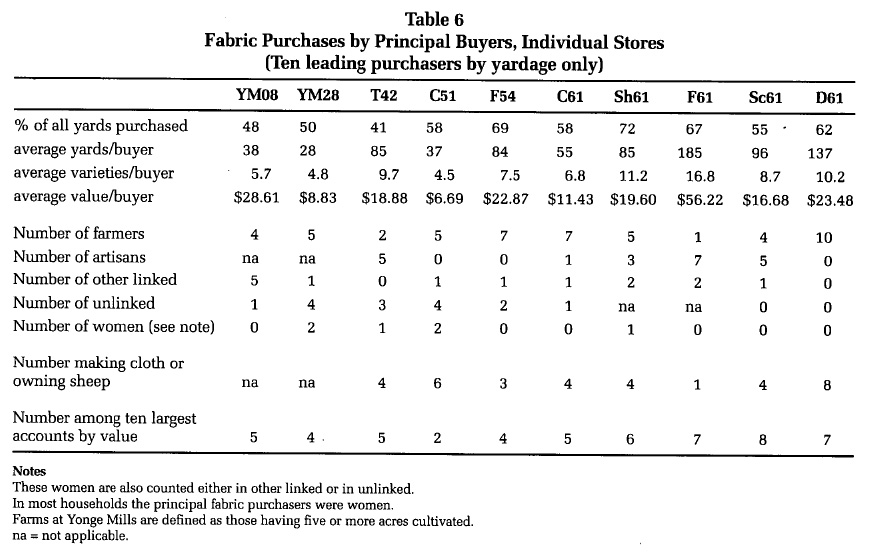 Display large image of Table 6
Display large image of Table 628 In terms of values, Fowlds' leading buyers were in a class of their own, with an average of $56.22, compared to $23.48 at Darling's. One reason for the difference was that Fowlds' buyers on average purchased 31 yards of woolens, compared to 10 at Darling's. In total, the value of Canadian fabric imports (discussed above) was equivalent to about $4.50 per capita in both 1851 and 1861. That was the cost to the wholesaler, not to the eventual retail buyer. It is all the more striking, therefore, that most sample households bought less than this on a per-person basis; in fact, the purchases of just 18 of the 50 leading buyers in 1861 summarized in Table 6 (nine of them at Fowlds') attained this threshold.32
29 To suggest the range of variation even among these principal buyers, the ten leading buyers in four of the samples are further considered in Table 7. There is a wide gap in every case between the lowest and highest figure, i.e., between the smallest and largest households, farms, accounts, and amount of cloth made. On every variable other than the volume of textile purchases, in fact, these households represent the range of the clientele rather than the high end of the distribution. Because the two 1861 stores with highest sales are included, there is a rising trend in yards purchased and frequency of transactions; still, ranges overlapped among the stores. The 69 yards purchased by the largest buyer at Yonge Mills in 1808 would have been seventh on the spectrum at Tett's, for example; the 133 yards of the largest buyer at Tett's would have ranked fifth at Darling's and ninth at Fowlds'.
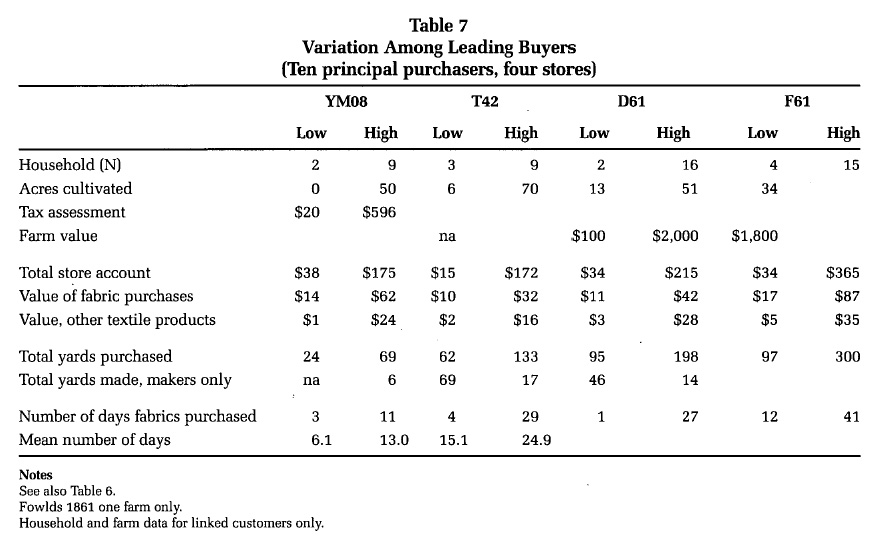 Display large image of Table 7
Display large image of Table 730 In the eight samples for which occupations are known, there were about thirty men with what could be called bourgeois occupations (merchants, teachers, clergymen, doctors, engineers, and lumber men). None were among the leading buyers; indeed, 13 bought no fabrics and another 9 bought minuscule amounts. A partial exception is Dr James Bingham, whose 24 yards purchased from Choate's in 1861 ranked him sixteenth. Among his purchases were 7 yards of woolen cloth valued at $1.10 per yard, a piece of cloth worth $6.80, and the most expensive linen sold at any store in 1861 (2.4 yards at 79¢ per yard). On the basis of value ($20.80), his was actually the leading Choate fabric account. It is possible that his purchases of such high value goods at this store reflected his growing links to the family; at any rate, he would marry Thomas Choate's daughter in 1862.33 Bingham aside, all of these leading buyers were ordinary Upper Canadian families. Their purchases suggest that other such families might have been buying similar amounts at other stores, or at the very least that they could aspire to this level of textile consumption.
31 Because the identity of the buyer is often specified in accounts, it is possible to say that most fabrics were purchased by women, even if charged to a household account in a man's name (husband, father, employer, etc.). In setting up the samples, special attention was given to ensure that women who had their own accounts were well represented. Among them was Catharine Parr Traill, whose writings are of course a key source on this topic. Respectfully accorded the occupation of "lady" in the census, she had an account at Sherin's that resembled those of the bourgeois men; the only fabric charged to her was a small piece (2.75 yards) of grey flannel, purchased by her son Walter. Like hers, many of the women's accounts proved to be very small. On the other hand, there are six women among the leading buyers in Table 6; four, like Phebe Murray, who purchased 25 yards of fabrics (valued at $5.20) from Yonge Mills in 1828-9, were in the samples with the lowest averages, however. At stores where leading customers had larger volumes, another nine women made purchases of 24 or more yards.34 Only six of the fifteen women were linked, but several are further identified in the accounts. Seven of the fifteen were likely widows; most of the others, Murray included, were servants. Her purchases represented half the value of her account; for the other five represented in Table 6 and most of the other women, textiles and textile-related purchases represented a considerably higher proportion of their accounts than that.
32 Some of the women in the sample must have earned some of their living by sewing, spinning, or weaving. A glimpse of this work is the account of James Bush, a 50 year old listed in the 1861 census as a labourer. His family of nine included five others who appeared in Fowlds' accounts: his wife (age 47), two sons, and two daughters. Among them, they purchased more than 171 yards of fabrics (one valuable piece was of unknown length), of 24 kinds, on 41 days between March and December 1861. At $85.10, this was the second ranked textile account among all 500 buyers in terms of value. Bush was credited with 16-½ days work for Fowlds at $1 per day and his son James Jr (age 24) with almost 7 months work at $18 per month. Mrs Bush was credited with $23.75 by making 4 pairs of drawers, 6 pairs of overalls, 26 pairs of pants, 19 shirts, and 3 vests; daughters Roselia (age 22) and "Miss" Bush (age 26) were also credited for smaller amounts of sewing. The phrasing of these credits clearly distinguishes them from the textiles they purchased. There is no way of knowing, however, if the Bushes were transforming some of their fabrics into clothing for sale to others, or sewing in part to be able to afford to have such fabrics for themselves.35
33 In fact, retail accounts offer only the briefest of glimpses of market-related sewing, because those hiring a seamstress, dressmaker, or tailor purchased fabrics and other material themselves and paid only for the work done with the materials. This is most clearly visible in the account of Christopher Chant, a tailor whose 133 yards, valued at almost $32, made him the leading buyer of fabrics (by volume and value) at Tett's. His account was also debited a total of $7 for thread, tape, pins, and other supplies. Such purchases seem far from sufficient for a year of work and could have been for his own family of nine. Made on twenty-seven different days, sometimes in very small pieces, almost all the transactions were by his wife, daughters, or a son. In addition, he or a member of his family charged sixteen yards (in as many pieces) to the accounts of six other customers in the sample, along with thread, buttons, tape, binding, and padding. Among the credits on his account were $25 for making various garments, including four coats, a vest, a suit, some "clothes," and a pair of trousers. Of the other six tailors in the samples, only one had a substantial account. This was Kenneth Urquhart, a 27-year-old bachelor who bought 30 yards of fabric worth $13.68 at Sherin's store and $1.32 worth of buttons in occasional small purchases. He also bought 21 yards of materials on one other customer's account. No doubt some of the material purchased by sample members was transformed by someone working for pay, but at this stage of research it seems unwise even to guess at orders of magnitude.
Conclusion
34 Few of the specific details of textile purchases in rural Upper Canada are likely to surprise specialists in the history of textiles elsewhere in colonial North America. Even so, the information from systematic use of a routinely generated source offers a sense of proportion in reading, and sorting among the conflicting images in, the extensive anecdotal literature on consumption. When taken together, moreover, the data produce a story very different from the one Brett (and many others) tell. In particular, the underlying idea that there was a transition from self-sufficiency to market orientation is wrong. Rather, and fundamentally, the story involves markets from the beginning.36 In a rural world that has been conceptualized as not being about markets, all the products discussed here had prices. So did many locally provided goods and services, such as those of the artisans who appear prominently among the leading buyers. Almost everywhere in Upper Canada respondents to Robert Gourlay's 1817 statistical survey could report, for example, the wages of women for housework and spinning, the prices of sheep, the yield of wool per sheep and the price of wool per pound.37 From the range and quantity of fabrics sold at Yonge Mills, it is clear that the principal kinds of fabrics were available in the countryside even in 1808. In allocating their time and resources, including those devoted to producing for their own consumption, settlers surely were guided by their knowledge of, and expectations about, such market matters. More than fifty years later, there had been no apparent trend away from cloth making; that is, it seems doubtful that families in the province's early years made any more cloth than those we have met in 1842,1851, and 1861. Nor was ready-made clothing a major part of the business of any of these stores in 1861. Even the Fowlds family, whose store had such large textile sales in 1861, also operated a carding and fulling mill.
35 Our image of the settlement era has been shaped in part by the conventions of various genres. One of them is the nineteenth-century reminiscence; whether speaking of hardship personally experienced or paying tribute to those who lived through privations, the author contrasts an earlier time with a later one, often exaggerating both the virtues and the difficulties of the earlier time.38 Another genre is history: historians are conventionally interested in change. Thus it is common in the literature on consumption to find sharply contrasting images of before and after as a way of highlighting a "revolution" in whatever period is chosen for study.39 Although it serves dramatic purposes to contrast isolation and a "largely self-sufficient" economy with the world of modern communications and, eventually, mass marketing, that phrasing diverts our attention from markets, consumption, and communication that already existed. To speak deterministically, as Brett does, of "necessity" is to miss the actual choices that women had.
36 Almost all the fabrics that the people (mainly women) in these samples were choosing at the country store fall into the middle ground between the often-emphasized extremes, homespun and high luxury. At every store individual cotton products were, in terms of yardage, the principal fabrics sold; in terms of values, cottons as a whole led by a wide margin, except at Fowlds'. Knowing that this was the era of the Industrial Revolution, we might have expected this, but cotton has been strangely absent from narratives based on anecdotal evidence.40 In a story of harsh Canadian winters and the need for warmth, we have underestimated the heat of the Ontario summer (or have assumed that linens took care of that, without demonstrating that there was sufficient domestic production in Upper Canada). As can be seen from the variety of colours and patterns in the pieces in surviving quilts, when women went to a store, they chose among products whose differences were visible. We can readily imagine them to have been as practical as Brett suggests, with an eye to value, in terms of price, quality and purpose. That is not inconsistent with having an eye for fashion, in the context of their lives, in colour, in fabric, in what they intended to make (or have made), in trim and accessories, and even in line and shape. During the period, more kinds of fabrics became available, stores found it paid to stock a greater number of fabrics, and quantities purchased rose. Particularly striking, because the example comes from well before the mid-century boom, is the level of consumption of leading Tett customers in 1842. But the rise in consumption was selective; many rural Upper Canadians continued to make woolen cloth (or have it made) and thus avoided buying too many expensive woolens.
37 From these records, we are not able to see why some bought little at a particular store or whether those who bought a great deal also bought textiles elsewhere. Some of the leading buyers were artisans (such as Eb Heath and Baptiste Touro [sic] the coopers who in 1861 were the leading buyers in terms of yardage at Scovil's and Fowlds' respectively). They, like the Chants and the Bush family, had close and complex relationships with the merchant. At Darling's, five leading buyers were also major wood suppliers, delivering in total almost 700 cords of wood in 1861; four of them had credits far exceeding the value of goods charged to their accounts. But many other large accounts did not have this character. The other five leading buyers at Darling's did not supply wood, and some large wood suppliers bought many fewer textiles.
38 These purchasers were, as we have seen, representative members of rural and village society. Some at least were buying very large amounts of textiles. These could be expensive, but for most families, on a per capita basis, the purchases that these accounts allow us access to were lower in value than the provincial average in 1861. Of those who exceeded the average, more than half were customers at Fowlds' store, in the largest village studied. That reminds us that, consumption was strongly structured by class and was likely to be both greater and different in urban centres.41 It seems altogether unlikely, in fact, that the standards of the urban elite, on whom fashion historians have often relied, are a reliable indication of textile consumption by the vast majority of early and mid-nineteenth century Upper Canadians who lived outside the main centres. Specialists in textile history would undoubtedly read much more than I have from what is (and is not) contained in the account books discussed here.42 The first step is to recognize that such sources exist. Even if the everyday products made from the textiles have not survived, there is much more information about the fabrics used in Upper Canada than we have hitherto recognized.
This paper forms part of the program of a Killam Research Fellowship, awarded by the Canada Council, and draws on research funded by the Social Sciences and Humanities Research Council of Canada. It is a pleasure to acknowledge the excellent research assistance of Laura Zink and Annette Fox, who gathered the accounts data, and of Erin Stewart, Jeralyne Manweiler, and Beth Yarzab. Kris Inwood, Rosemary Ommer, Robert Sweeny, and Robert Hong offered valuable advice at crucial stages in the project's development. An earlier version of this paper was presented at the Canadian Historical Association Meeting in Edmonton, May 2000. Revisions have benefited from very helpful discussions with Dr Alexandra Palmer, Royal Ontario Museum; Kim Reid, Peterborough Centennial Museum and Archives; Marika Kerkhoven, Museum for Textiles (Toronto); Audrey Caryi, Lang Pioneer Village; and Bernadine Dodge, Trent University Archives. Steve Gardiner prepared the map and Michael Cullen of Trent Photographies prepared the other illustrations.
